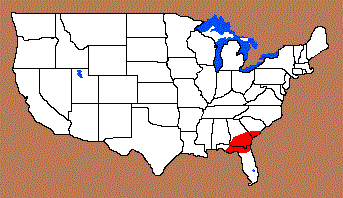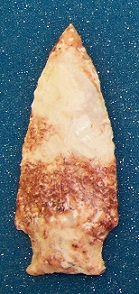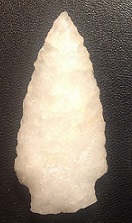Outline is Representative of Size and Shape:


Name Details:
Identified By: David Topper
Named For: Type Site
Date Identified: 1976
Type Site: Allendale Quarry Site, Allendale County, South Carolina
Identified By: David Topper
Named For: Type Site
Date Identified: 1976
Type Site: Allendale Quarry Site, Allendale County, South Carolina
Point Validity:
Collector type
Topper is an avocational archaeologist who has studies the archaeology of South Carolina. John Whatley (2002) is a well published avocational archaeologist who discussed this type in terms of the Piedmont of Georgia. There are several collector and avocational archaeologist references to this type. No professional references were located. This is considered a collector type.
Topper is an avocational archaeologist who has studies the archaeology of South Carolina. John Whatley (2002) is a well published avocational archaeologist who discussed this type in terms of the Piedmont of Georgia. There are several collector and avocational archaeologist references to this type. No professional references were located. This is considered a collector type.
Allendale Expanding Stem
AKA: MALA (Middle Archaic Late Archaic)Cluster:
Description of Physical Characteristics and Flaking Pattern:
This is a thick medium (1.75 to 3 inches) triangular to lanceolate expanding stem point with an elliptical cross section. The blade is slightly excurvate and may vary to straight. The shoulders mar vary from prominent to weak and may range from horizontal to having a slightly upward angle. The stem is short and may varies from straight to slightly expanding. The base varies from slightly convex to slightly convex and commonly has sharp basal corners. Whatley (2003) notes that commonly one basal corner is damaged due to use. This point has a random flaking pattern.
Size Measurements:
Total Length - 33 to 51 mm (average 39 to 42 mm), Stem Length - 6 to 9 mm (average 7 mm), Blade Width - 18 to 31 mm (average 20 to 23 mm), Neck Width - 12 to 17 mm (average 14 to 15 mm), Stem Width - 13 to 18 mm (average 14 to 16 mm), Thickness - 6 to 10 mm (Whatley 2002).
Total Length - 33 to 51 mm (average 39 to 42 mm), Stem Length - 6 to 9 mm (average 7 mm), Blade Width - 18 to 31 mm (average 20 to 23 mm), Neck Width - 12 to 17 mm (average 14 to 15 mm), Stem Width - 13 to 18 mm (average 14 to 16 mm), Thickness - 6 to 10 mm (Whatley 2002).
Additional Comments:
Loyd Doty reports: ALLENDALE (Expanded Stem) – was named by amateur David Topper for examples he recovered from the Allendale quarry site (Topper Site) and other sites in Allendale County, South Carolina. The type is a regional variant only found in a small area of the Piedmont in the southeast. They are medium sized (2 ½ to 3”) projectiles or knives with expanding blades, strong shoulders that are straight or round and short stems with straight to convex bases. Distribution includes South Carolina, Georgia, northern Florida and they were in use during the late Archaic period. The material many of these points are made from is Allendale Quarry chert quarried in Allendale county South Carolina.
Reference: Lewis-East, G. S 2002, Early and Late Archaic Occupations along the Savannah River, Aiken County, South Carolina (also by K. E. Sassaman with I. R. Daniel, Jr. and C. R. Moore). Savannah River Archaeological Research Papers 12.
K.E. Sassaman referred to these points as MALA points in his survey of the Savanna River sites in South Carolina
Loyd Doty reports: ALLENDALE (Expanded Stem) – was named by amateur David Topper for examples he recovered from the Allendale quarry site (Topper Site) and other sites in Allendale County, South Carolina. The type is a regional variant only found in a small area of the Piedmont in the southeast. They are medium sized (2 ½ to 3”) projectiles or knives with expanding blades, strong shoulders that are straight or round and short stems with straight to convex bases. Distribution includes South Carolina, Georgia, northern Florida and they were in use during the late Archaic period. The material many of these points are made from is Allendale Quarry chert quarried in Allendale county South Carolina.
Reference: Lewis-East, G. S 2002, Early and Late Archaic Occupations along the Savannah River, Aiken County, South Carolina (also by K. E. Sassaman with I. R. Daniel, Jr. and C. R. Moore). Savannah River Archaeological Research Papers 12.
K.E. Sassaman referred to these points as MALA points in his survey of the Savanna River sites in South Carolina
Distribution:

Distribution Comments:
This is primarily found in the central to lower Savannah River Plain of South Carolina and Georgia. This point is primarily found in areas associated with Anasazi sites. This point may be found on the Colorado Plateau in the southern Manti La Sal range and southward to the Su Site of New Mexico and westward to Navajo Mountain.
This is primarily found in the central to lower Savannah River Plain of South Carolina and Georgia. This point is primarily found in areas associated with Anasazi sites. This point may be found on the Colorado Plateau in the southern Manti La Sal range and southward to the Su Site of New Mexico and westward to Navajo Mountain.
Age / Periods:
Date: 4,000 - 3,000 B.P.
Cultural Period: Late Archaic to Early
Woodland
Glacial Period: Neoglacial
Culture:
Date: 4,000 - 3,000 B.P.
Cultural Period: Late Archaic to Early
Woodland
Glacial Period: Neoglacial
Culture:
Age Details:
Radiocarbon dating at the Phinizy Swamp site in Richmond County, Georgia returned dates of 4,805 +/- 139 BP (Elliott et al.l994:164, 193). Whatley (2002) notes that no radiocarbon dating has been conducted on stratified sites containing Allendale points. But both are now considered the same type and should have the same dates.
Radiocarbon dating at the Phinizy Swamp site in Richmond County, Georgia returned dates of 4,805 +/- 139 BP (Elliott et al.l994:164, 193). Whatley (2002) notes that no radiocarbon dating has been conducted on stratified sites containing Allendale points. But both are now considered the same type and should have the same dates.
Other points in this cluster / Related / Associated Points:




